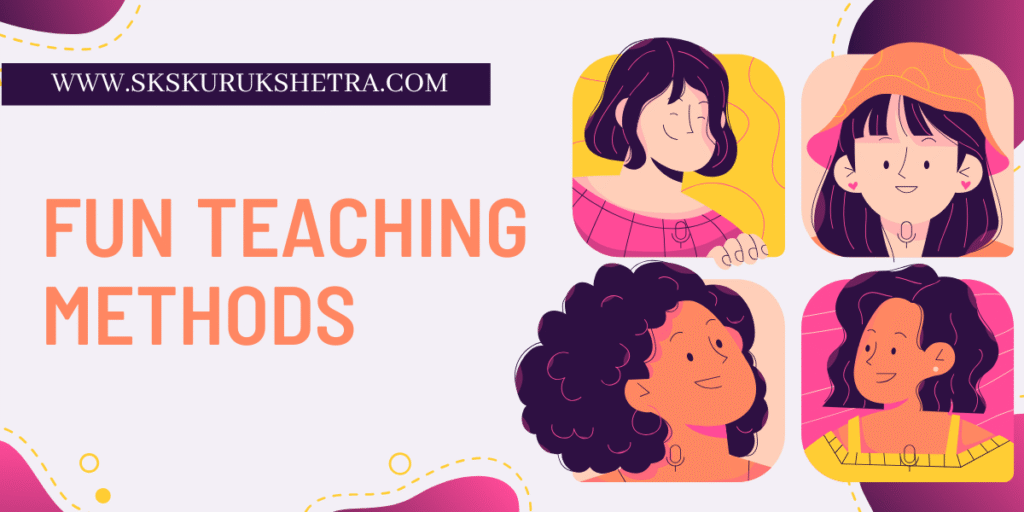In today’s fast-paced world, keeping students engaged can be a real challenge. Traditional lectures and rote memorization often leave learners disinterested and unmotivated.
That’s where fun teaching methods come into play.
By incorporating creativity, interactivity, and play into lessons, educators can spark curiosity, deepen understanding, and foster a lifelong love of learning.
This article explores every facet of fun teaching methods—what they are, why they matter, how to implement them, and real-world examples to inspire your own classroom transformation.
Must Read: Ways to Develop Critical Thinking Skills | SKS Group of Colleges
Why Fun Teaching Methods Matter
- Boost Engagement: When students enjoy lessons, they participate more actively, ask questions, and take ownership of their learning.
- Enhance Retention: Fun activities make information memorable by linking concepts to experiences and emotions.
- Develop Soft Skills: Collaborative games and projects build teamwork, communication, and problem-solving skills.
- Cultivate Creativity: Innovative approaches encourage students to think outside the box and express themselves.
Principles Behind Engaging Lessons
- Active Learning: Shift from passive listening to hands-on experiences.
- Relevance: Connect content to real-life scenarios students care about.
- Variety: Rotate activities—games, discussions, multimedia—to maintain interest.
- Choice: Allow learners to pick projects or topics aligned with their passions.
- Positive Feedback: Celebrate effort and progress to build confidence.
Game-Based Learning
Overview: Integrates game elements—points, levels, challenges—into lessons.
- Types of Games:
- Quiz Battles: Students compete in teams to answer questions.
- Escape Rooms: Solve subject-based puzzles to “escape” the classroom.
- Digital Simulations: Use educational apps or platforms for interactive gameplay.
- Implementation Tips:
- Clearly define learning objectives before choosing a game format.
- Balance competition with collaboration to avoid stress.
- Debrief after the game to reinforce key concepts.
Project-Based Learning (PBL)
Overview: Students investigate and respond to complex questions or challenges over an extended period.
- Key Features:
- Real-World Connection: Projects mirror authentic issues (e.g., designing a community garden).
- Interdisciplinary Approach: Blend science, math, art, and language skills.
- Student Autonomy: Learners plan, research, and present findings.
- Step-by-Step Guide:
- Kickoff Event: Launch with a question or problem scenario.
- Research Phase: Guide students in gathering reliable information.
- Creation: Learners build models, write reports, or produce videos.
- Presentation: Share outcomes with peers or community members.
- Reflection: Discuss successes, challenges, and improvements.
Experiential Learning
Overview: Learning by doing—field trips, labs, role plays.
- Examples:
- Science Experiments: Let students design and conduct simple experiments.
- Historical Reenactments: Dress up and act out significant events.
- Community Service: Apply classroom lessons to help local organizations.
- Benefits:
- Deepens understanding through sensory experiences.
- Builds empathy by stepping into others’ shoes.
- Encourages critical thinking and decision-making.
Technology-Enhanced Lessons
Overview: Use digital tools to enrich learning.
- Tools & Platforms:
- Interactive Whiteboards: Encourage collaborative problem-solving.
- Educational Apps: From language learning games to math puzzles.
- Virtual Reality (VR): Immerse students in historical sites or scientific environments.
- Best Practices:
- Ensure technology aligns with curriculum goals.
- Provide clear instructions and tech support.
- Maintain a balance—don’t let screens dominate every lesson.
Storytelling and Narrative
Overview: Harness the power of stories to explain concepts.
- Techniques:
- Personal Anecdotes: Teachers share relatable experiences.
- Case Studies: Real-life examples to illustrate abstract ideas.
- Interactive Stories: Students choose story paths based on decisions, reinforcing cause-and-effect.
- Why It Works: Narratives tap into emotions, making information stick and promoting empathy.
Role-Play and Simulations
Overview: Students assume characters or roles to explore subject matter.
- Applications:
- Language Arts: Act out scenes from novels or plays.
- Social Studies: Debate as historical figures in a mock congress.
- Science: Play the role of researchers identifying species in a “virtual jungle.”
- Implementation Tips:
- Assign clear roles and objectives.
- Encourage creativity in costumes or props.
- Hold a debrief to connect the activity to learning goals.
Flipped Classroom Model
Overview: Students review lecture materials at home and engage in interactive activities in class.
- Process:
- Pre-Class Preparation: Record short videos or share readings.
- In-Class Application: Solve problems, conduct experiments, or discuss case studies.
- Feedback Loop: Teachers circulate to support and assess understanding.
- Advantages:
- Maximizes hands-on learning time.
- Supports differentiated instruction—students can learn at their own pace.
Collaborative Learning Structures
Overview: Students work together in small groups to achieve shared goals.
- Popular Models:
- Think-Pair-Share: Individual thinking, then partner discussion, then group sharing.
- Jigsaw: Each student becomes an “expert” on one topic segment and teaches peers.
- Group Projects: Teams tackle complex problems, presenting collective solutions.
- Key Considerations:
- Define roles (facilitator, recorder, presenter).
- Monitor group dynamics to ensure equal participation.
- Use rubrics to assess both group and individual contributions.
Arts-Integrated Learning
Overview: Blend art forms (visual art, music, drama) with academic content.
- Ideas:
- Musical Mnemonics: Create songs to memorize formulas or vocabulary.
- Poster Creation: Illustrate concepts through drawings or infographics.
- Creative Writing: Compose poems or short stories reflecting historical periods.
- Benefits:
- Engages multiple intelligences.
- Offers alternative pathways for learners who struggle with traditional methods.
Mindfulness and Brain Breaks
Overview: Short activities to reset attention and reduce stress.
- Examples:
- Guided Breathing: Two-minute breathing exercises between lessons.
- Stretch Breaks: Simple physical movements to re-energize.
- Brain Teasers: Quick puzzles or riddles to shift cognitive gears.
- Why Include Them: Improves focus, lowers anxiety, and boosts cognitive performance.
Real-World Connections and Guest Speakers
Overview: Invite experts or organize virtual field trips.
- Strategies:
- Industry Professionals: Engineers, writers, or entrepreneurs share career insights.
- Alumni Talks: Former students discuss how classroom concepts apply in college or work.
- Virtual Tours: Museums, factories, or research labs via live video.
- Outcomes: Bridges gap between theory and practice, motivating students by showing relevance.
Personalized Learning Paths
Overview: Tailor content, pace, and activities to individual student needs.
- Approaches:
- Learning Stations: Rotating centers focusing on different skills or interests.
- Choice Boards: Menu of activities allowing students to select tasks.
- Adaptive Software: Programs that adjust difficulty based on performance.
- Benefits: Promotes autonomy, meets diverse learning needs, and fosters self-regulation.
Assessment as Learning
Overview: Use formative, interactive assessments that feel like games.
- Formats:
- Exit Tickets: Quick quizzes via paper or digital polls.
- Peer Review Sessions: Students give feedback on each other’s work.
- Interactive Surveys: Live polling to check understanding mid-lesson.
- Tips:
- Keep questions low-stakes and focused on key takeaways.
- Provide immediate feedback to reinforce learning.
Among institutions embracing these innovative methods, SKS Group of Colleges near NIT, Kirmach Road, Kurukshetra, shines bright.
With a commitment to hands-on learning, SKS integrates game-based labs, collaborative projects, and expert guest lectures into its curriculum.
Students actively participate in mock legal debates, pharmacy simulations, and educational outreach programs—experiences that not only reinforce academic concepts but also nurture leadership and critical thinking.
Such real-world engagement positions SKS graduates for success and reflects the college’s dedication to fun, effective teaching.
Overcoming Common Challenges
- Time Constraints: Start small—introduce one fun element per week and scale up.
- Limited Resources: Use free online tools, repurpose classroom materials, or partner with local businesses.
- Classroom Management: Establish clear rules, rotate roles, and maintain consistent routines.
- Assessment Pressure: Balance fun activities with clear learning targets and rubrics.
Tips for Sustainable Implementation
- Plan Ahead: Map fun activities to curriculum standards and deadlines.
- Gather Feedback: Regularly survey students on what they enjoy and learn best.
- Collaborate: Share ideas with colleagues and co-create interdisciplinary activities.
- Reflect & Adapt: After each session, note what worked and tweak accordingly.
Must Read: Public Speaking Tips for Beginners In 2025-26
Conclusion
Adopting fun teaching methods transforms classrooms from passive lecture halls into dynamic learning hubs.
By weaving games, projects, storytelling, and technology into daily lessons, educators can ignite student passion, deepen understanding, and build essential skills for the future.
Whether you’re a seasoned teacher or just starting out, integrating these approaches—tailored to your subject and students—will revitalize your teaching practice and create unforgettable learning experiences.
Embrace creativity, encourage exploration, and watch your learners thrive!

